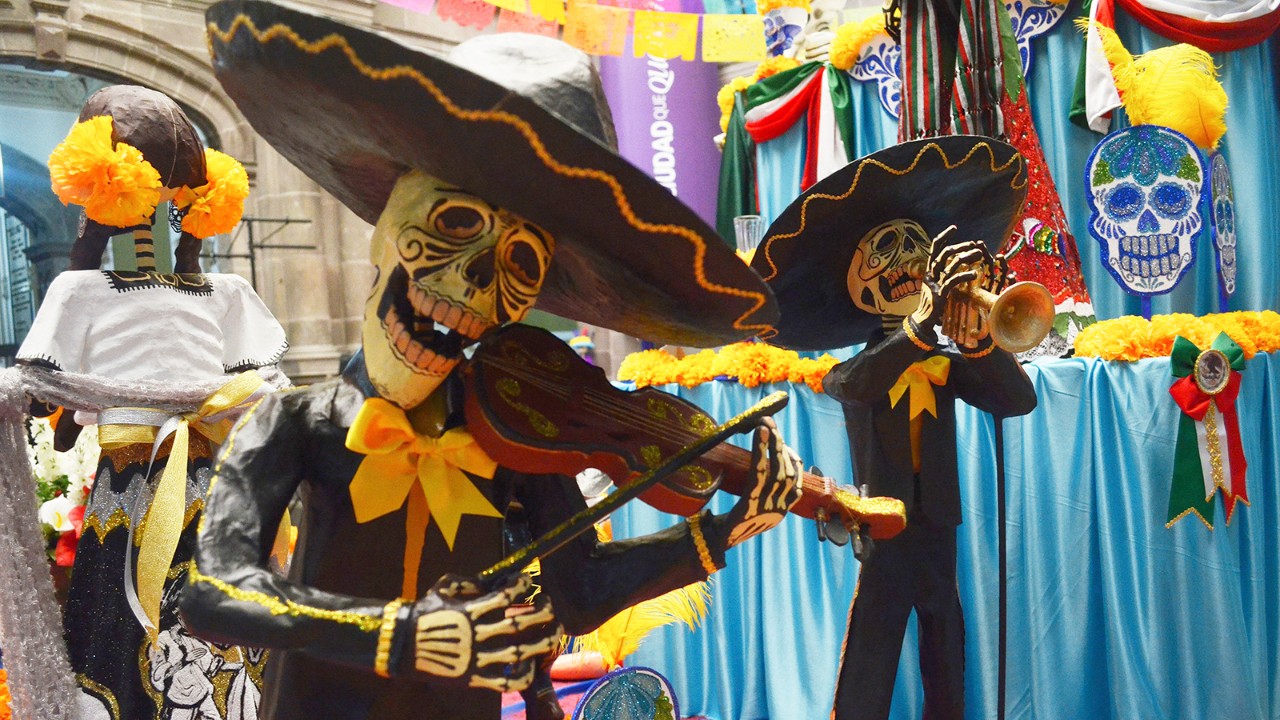About the Holiday
The Creative Arts Guild could not be more proud to be the host of an event that celebrates ancestry and incorporates art and ritual - celebrating a culture that is so rich and vibrant in our community. We invite our entire community to celebrate with us!
Dia de los Muertos History and Traditions
 Dia de los Muertos—the Day of the Dead—is a holiday celebrated on November 1 (as well as October 31 and Novmeber 2 to coincide with the Western Christianity triduum of Allhallowtide: All Saints' Eve, All Saints' Day, and All Souls' Day). Although marked throughout Latin America, Dia de los Muertos is most strongly associated with Mexico, where the tradition originated.
Dia de los Muertos—the Day of the Dead—is a holiday celebrated on November 1 (as well as October 31 and Novmeber 2 to coincide with the Western Christianity triduum of Allhallowtide: All Saints' Eve, All Saints' Day, and All Souls' Day). Although marked throughout Latin America, Dia de los Muertos is most strongly associated with Mexico, where the tradition originated.
Dia de los Muertos honors the dead with festivals and lively celebrations, a typically Latin American custom that combines indigenous Aztec ritual with Catholicism, brought to the region by Spanish conquistadores. (Dia de los Muertos is celebrated on All Saints Day and All Souls Day, minor holidays in the Catholic calendar.)
Assured that the dead would be insulted by mourning or sadness, Dia de los Muertos celebrates the lives of the deceased with food, drink, parties, and activities the dead enjoyed in life. Another tradition connected with the holiday is building private altars called ofrendas, honoring the deceased using calaveras, aztec marigolds, and the favorite foods and beverages of the departed, and visiting graves with these as gifts. Visitors also leave possessions of the deceased at the graves. Dia de los Muertos recognizes death as a natural part of the human experience, a continuum with birth, childhood, and growing up to become a contributing member of the community.

On Dia de los Muertos, the dead are also a part of the community, awakened from their eternal sleep to share celebrations with their loved ones.
The Day of the Dead celebrations in Mexico developed from ancient traditions among its pre-Columbian cultures. Rituals celebrating the deaths of ancestors had been observed by these civilizations perhaps for as long as 2,500–3,000 years. The festival that developed into the modern Day of the Dead fell in the ninth month of the Aztec calendar, about the beginning of August, and was celebrated for an entire month. The festivities were dedicated to the goddess known as the "Lady of the Dead", corresponding to the modern La Calavera Catrina.
By the late 20th century in most regions of Mexico, practices had developed to honor dead children and infants on November 1, and to honor deceased adults on November 2. November 1 is generally referred to as Día de los Inocentes ("Day of the Innocents") but also as Día de los Angelitos ("Day of the Little Angels"); November 2 is referred to as Día de los Muertos or Día de los Difuntos ("Day of the Dead").
On October 31, All Hallows Eve, the children make a children's altar to invite the angelitos (spirits of dead children) to come back for a visit. November 1 is All Saints Day, and the adult spirits will come to visit. November 2 is All Souls Day, when families go to the cemetery to decorate the graves and tombs of their relatives. The three-day fiesta is filled with marigolds, the flowers of the dead; muertos (the bread of the dead); sugar skulls; cardboard skeletons; tissue paper decorations; fruit and nuts; incense, and other traditional foods and decorations.
People go to cemeteries to be with the souls of the departed and build private altars containing the favorite foods and beverages, as well as photos and memorabilia, of the departed. The intent is to encourage visits by the souls, so the souls will hear the prayers and the comments of the living directed to them. Celebrations can take a humorous tone, as celebrants remember funny events and anecdotes about the departed.
Mexican cempasúchil (marigold) is the traditional flower used to honor the dead
Plans for the day are made throughout the year, including gathering the goods to be offered to the dead. During the three-day period families usually clean and decorate graves; most visit the cemeteries where their loved ones are buried and decorate their graves with ofrendas (altars), which often include orange Mexican marigolds (Tagetes erecta) called cempasúchil (originally named cempoaxochitl, Nāhuatl for "twenty flowers"). In modern Mexico the marigold is sometimes called Flor de Muerto (Flower of Dead). These flowers are thought to attract souls of the dead to the offerings. It is also believed the bright petals with a strong scent can guide the souls from cemeteries to their family homes.
Toys are brought for dead children (los angelitos, or "the little angels"), and bottles of tequila, mezcal or pulque or jars of atole for adults. Families will also offer trinkets or the deceased's favorite candies on the grave. Some families have ofrendas in homes, usually with foods such as candied pumpkin, pan de muerto ("bread of dead"), and sugar skulls; and beverages such as atole. The ofrendas are left out in the homes as a welcoming gesture for the deceased. Some people believe the spirits of the dead eat the "spiritual essence" of the ofrendas food, so though the celebrators eat the food after the festivities, they believe it lacks nutritional value. Pillows and blankets are left out so the deceased can rest after their long journey. In some parts of Mexico, such as the towns of Mixquic, Pátzcuaro and Janitzio, people spend all night beside the graves of their relatives. In many places, people have picnics at the grave site, as well.
Some families build altars or small shrines in their homes; these sometimes feature a Christian cross, statues or pictures of the Blessed Virgin Mary, pictures of deceased relatives and other people, scores of candles, and an ofrenda. Traditionally, families spend some time around the altar, praying and telling anecdotes about the deceased. In some locations, celebrants wear shells on their clothing, so when they dance, the noise will wake up the dead; some will also dress up as the deceased.
Public schools at all levels build altars with ofrendas, usually omitting the religious symbols. Government offices usually have at least a small altar, as this holiday is seen as important to the Mexican heritage.
Those with a distinctive talent for writing sometimes create short poems, called calaveras (skulls), mocking epitaphs of friends, describing interesting habits and attitudes or funny anecdotes. This custom originated in the 18th or 19th century after a newspaper published a poem narrating a dream of a cemetery in the future, "and all of us were dead", proceeding to read the tombstones. Newspapers dedicate calaveras to public figures, with cartoons of skeletons in the style of the famous calaveras of José Guadalupe Posada, a Mexican illustrator. Theatrical presentations of Don Juan Tenorio by José Zorrilla (1817–1893) are also traditional on this day.
José Guadalupe Posada created a famous print of a figure he called La Calavera Catrina ("The Elegant Skull") as a parody of a Mexican upper-class female. Posada's striking image of a costumed female with a skeleton face has become associated with the Day of the Dead, and Catrina figures often are a prominent part of modern Day of the Dead observances.
A common symbol of the holiday is the skull (in Spanish calavera), which celebrants represent in masks, called calacas (colloquial term for skeleton), and foods such as sugar or chocolate skulls, which are inscribed with the name of the recipient on the forehead. Sugar skulls can be given as gifts to both the living and the dead. Other holiday foods include pan de muerto, a sweet egg bread made in various shapes from plain rounds to skulls and rabbits, often decorated with white frosting to look like twisted bones.
The traditions and activities that take place in celebration of the Day of the Dead are not universal, often varying from town to town. For example, in the town of Pátzcuaro on the Lago de Pátzcuaro in Michoacán, the tradition is very different if the deceased is a child rather than an adult. On November 1 of the year after a child's death, the godparents set a table in the parents' home with sweets, fruits, pan de muerto, a cross, a rosary (used to ask the Virgin Mary to pray for them) and candles. This is meant to celebrate the child's life, in respect and appreciation for the parents. There is also dancing with colorful costumes, often with skull-shaped masks and devil masks in the plaza or garden of the town. At midnight on November 2, the people light candles and ride winged boats called mariposas (butterflies) to Janitzio, an island in the middle of the lake where there is a cemetery, to honor and celebrate the lives of the dead there.
In contrast, the town of Ocotepec, north of Cuernavaca in the State of Morelos, opens its doors to visitors in exchange for veladoras (small wax candles) to show respect for the recently deceased. In return the visitors receive tamales and atole. This is done only by the owners of the house where someone in the household has died in the previous year. Many people of the surrounding areas arrive early to eat for free and enjoy the elaborate altars set up to receive the visitors.
Dia de los Muertos Food
During Day of the Dead festivities, food is both eaten by living people and given to the spirits of their departed ancestors as ofrendas ("offerings"). Tamales are one of the most common dishes prepared for this day for both purposes.
Pan de muerto and calaveras are associated specifically with Day of the Dead. Pan de muerto is a type of sweet roll shaped like a bun, topped with sugar, and often decorated with bone-shaped phalanges pieces. Calaveras, or sugar skulls, display colorful designs to represent the vitality and individual personality of the departed.
In addition to food, drink is also important to the tradition of Day of the Dead. Historically, the main alcoholic drink was pulque while today families will commonly drink the favorite beverage of their deceased ancestors. Other drinks associated with the holiday are atole and champurrado, warm, thick, non-alcoholic masa drinks.
Jamaican iced tea is a popular herbal tea made of the flowers and leaves of the Jamaican hibiscus plant (Hibiscus sabdariffa), known as flor de Jamaica in Mexico. It is served cold and quite sweet with a lot of ice. The ruby-red beverage is called hibiscus tea in English-speaking countries and called agua de Jamaica (water of Jamaica) in Spanish.

